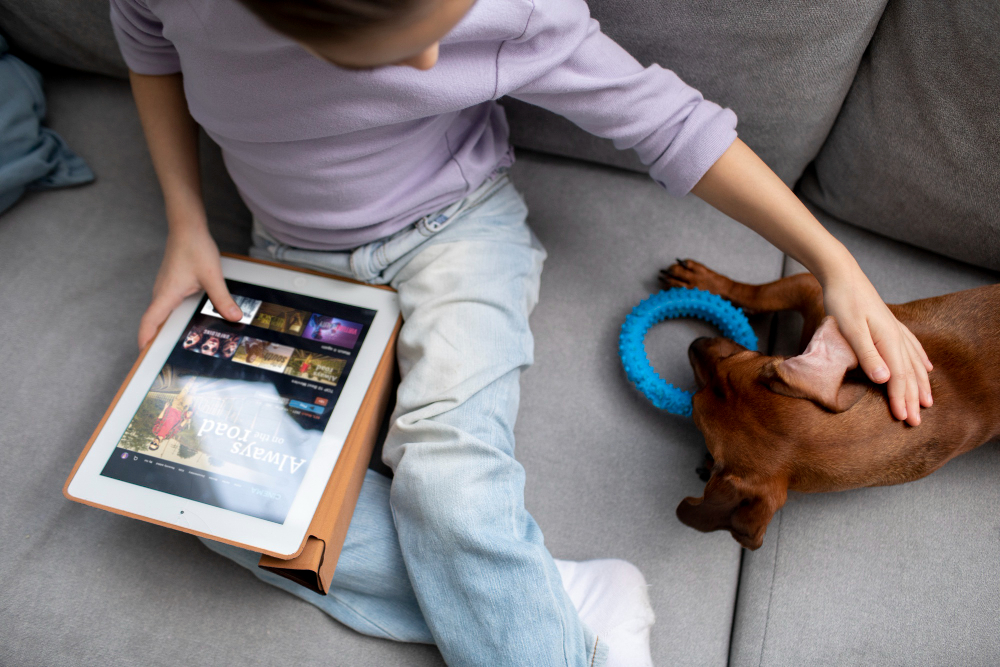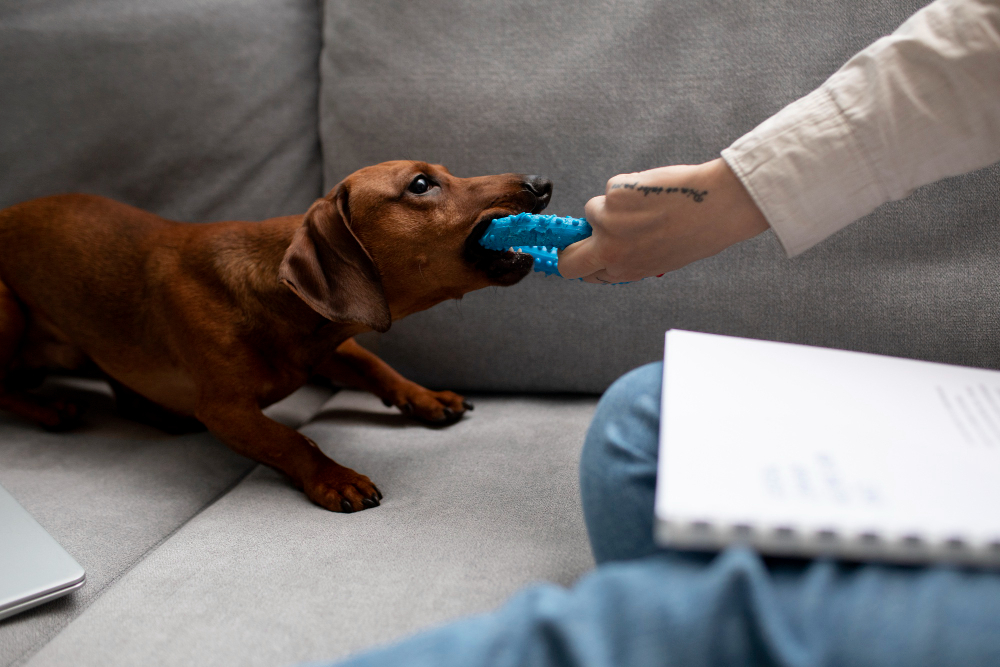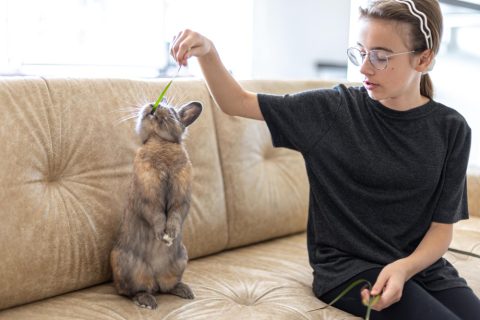Every dog has their quirks. Maybe yours insists on sitting next to your partner at every meal, or only listens when your teenager gives commands. While it might seem harmless—even endearing—favoritism can cause real imbalances in your household. Dogs that pick favorites may ignore other family members, act possessive, or become anxious when their preferred person leaves the room.
Luckily, with the right approach, you can teach your dog to spread the love a little more evenly. Here’s how to recognize the signs, understand what’s really going on, and gently guide your pup toward better balance.
Looking to build better habits overall? Don’t miss our guide on Daily Dog Training Made Simple.
Contents
Why Some Dogs Pick Favorites (And Why It Matters)
If you’ve noticed that your dog seems to adore one person in the family while ignoring the rest, you’re not alone. It’s common for dogs to show favoritism—choosing one human to follow, cuddle with, or obey. But while it might seem cute at first, favoritism can lead to long-term behavioral issues like separation anxiety, selective listening, or even growling at others who “invade” their chosen human’s space.
As pet owners, we all want a happy, well-balanced pup who feels safe with everyone in the household—not just one person. That’s where thoughtful, consistent boundary training comes into play.
Understanding the Root: What “Favoritism” Really Means to Dogs
At its core, favoritism is often the result of accidental reinforcement. One person may be feeding the dog more treats, offering more cuddles, or letting little disobediences slide. Dogs are clever—they quickly figure out who gives the most rewards with the fewest rules.
Favoritism may also stem from the dog’s sense of pack hierarchy. In the dog’s mind, the “favorite” might be seen as the leader or the most comforting presence. But left unchecked, this can create tension, insecurity, and confusion—especially when other family members try to step in.
It’s not about blaming anyone. It’s about creating consistency, balance, and emotional security for your dog.
How to Train Your Dog to Treat Everyone Equally
Step 1: Notice the Patterns
Start by observing when your dog gravitates toward a specific person. Is it around feeding time? During stressful events? After certain commands are given?
Pay attention to subtle signs like:
- Ignoring commands from others
- Following one person from room to room
- Growling or guarding behavior near a specific human
- Preferring to sit on one lap over others—even if others invite them
By identifying the trigger points, you’ll know where to start shifting the behavior.
Step 2: Distribute Responsibilities Equally
Let’s say your dog loves your partner and ignores you. Instead of forcing interaction, begin reassigning daily responsibilities. If your partner usually feeds the dog, take over that task a few times a week. Alternate who takes the dog for walks, gives treats, or leads playtime.
Dogs associate trust and loyalty with routine interaction, not just affection. By spreading out tasks, your dog learns to look to everyone in the household for guidance and care.
Tip: Be sure every family member uses the same verbal cues and hand signals. Consistency builds confidence.
Step 3: Reward Neutrality and Independence
If your dog constantly seeks attention from their “favorite person,” teach them that calm, independent behavior gets rewarded too.
When your dog chooses to sit in a neutral space instead of leaning on their favorite, praise them. Offer a small treat or simply pet them gently. Reinforce the idea that everyone’s attention is valuable—not just one person’s.
This step is especially helpful in households with children. Teaching dogs to be neutral around kids (and vice versa) is key to building trust on both sides.

Boundary Setting for Balanced Behavior
Favoritism often links back to a lack of boundaries. One person might be more permissive—letting the dog on the bed, ignoring bad behavior, or offering treats “just because.”
Dogs thrive in environments where they know the rules. Setting healthy emotional and spatial boundaries teaches them to respect every member of the pack.
Practical Tips for Neutral Space Training:
- Create neutral rest areas like dog beds in common rooms instead of personal bedrooms.
- Avoid allowing your dog to sleep in bed with one person only. This may reinforce the idea that they “belong” to that individual.
- During meal times or family gatherings, keep the dog in a shared space with a chew toy or calming treat—away from laps and feet.
- Use gentle redirection if the dog tries to climb onto someone’s lap obsessively. Reward calm behavior on the floor or beside everyone equally.
This kind of structure is similar to what places like Happy Tails Pet Resort or Pet Nutrition Alliance promote in group environments. Dogs do better when expectations are clear and evenly enforced.
Want to teach similar self-control skills to your cat? Check out our article on How to Train Your Cat to Focus Around Distractions.
What Not to Do: Avoid Reinforcing the Bias
It’s natural to want to feel “special” to your pet. But if you know your dog plays favorites, resist the urge to deepen that dynamic.
Here’s what to avoid:
- Don’t over-coddle or allow clingy behavior
- Avoid using food as the only way to win affection
- Don’t dismiss other family members’ training efforts
- Avoid joking about your dog “not liking” someone—it can become a self-fulfilling cycle
Instead, focus on building your dog’s emotional flexibility. That way, they’re just as happy walking with dad as they are cuddling with grandma or playing fetch with the kids.
Bonus: This also helps when traveling or boarding your pet—something people with pet friendly hotels or pet insurance in Colorado or NYC in mind often forget to consider.
Final Thoughts: Equal Love, Better Manners
At the end of the day, favoritism isn’t about your dog being “rude” or “mean.” It’s just a signal that they’re looking for clarity in leadership and routine.
By teaching your dog that everyone is a safe, reliable, and respected figure, you’ll create a stronger bond—not just between you and your pet, but among the whole family.
Remember:
- Dogs aren’t born biased—they learn from what we show them.
- Consistency builds trust.
- Boundaries build emotional balance.
- Love isn’t about giving in—it’s about giving guidance.
Training your dog to stop picking favorites may take a little patience and intention, but the result is worth it: a calm, confident companion who brings joy to everyone in the home—not just a chosen few.






